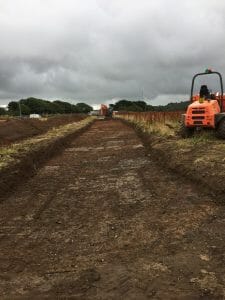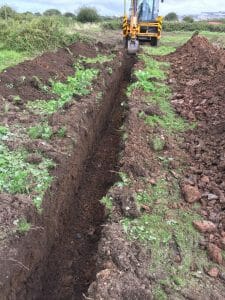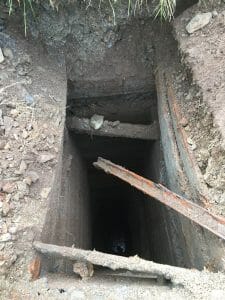KNOWLEDGE IS POWER: WHY UNDERSTANDING WHAT LIES BENEATH CAN PROVE PRICELESS FOR DEVELOPERS
For developers and housebuilders there is often enough to contend with above ground, when undertaking a new housing or structural project, making the process of assessing what lies beneath often an afterthought. However, while the golden age of mining may be over, mines continue to leave a legacy on the land in today’s property and development market, having the potential to significantly impact today’s developers long before the first brick is placed.
Historic mining activity is still affecting the modern property and land development market, and if not identified early enough, has the potential to wipe thousands off a land or home’s value. This is not just an issue facing known mining ‘hot spots’, such as Cornwall, with over 150,000 abandoned mines known to exist across the UK. Identifying and remediating mining risks can not only help in the construction of a safe development or property but can also play a significant role in early sale negotiations, helping to save money in the long term.
Brian Poole, Senior Geologist at Mining Searches UK, outlines why mining risk assessments are crucial in today’s property market, as well as how they play a vital role in mitigating risk, negotiating best price and guiding development design.
Mining matters
Mining risk assessments are vital in today’s property, construction and development market, and essential for determining whether there is any evidence of historic mining activity on an area of land. This is important even for locations where there are no obvious signs of mining, and while closed mines leave little evidence on the surface they still have the potential to cause major problems – including putting a stop to construction plans.
To ensure land is purchased and sold at the best price, it can prove valuable to know the finer workings of the area in question, given sizeable financial investments are often at stake, along with the safety of future workers, homeowners and building residents. Developers aware of land with a known mine can potentially negotiate value down considerably, and if mine workings are identified and remediated, can potentially propel value up by over 100%.
For Redruth-based housebuilding firm Percy Williams and Sons Ltd., mining risk assessments proved vital during the initial stages of planning and preparation for construction of a new community in Tolgus, Cornwall – which includes 370 new homes, as well as a range of community facilities. Managing Director, Simon Williams said: “The area earmarked for redevelopment is substantial, 13.3 hectares, with a mixture of residential and commercial use planned for the site. Before planning, it was essential that we understood in detail what was beneath the ground, before committing machinery and workers onsite – removing risks to ensure construction can take place, while helping to protect our financial investment.
“As it was historically a well-known active mining area, we worked with mining risk assessment specialists from Mining Searches UK to identify and solve the mining problems. This included research by engineers and archivists to pinpoint mining features across the site by referencing old records, plans and maps, eventually revealing that several old mine shafts were present.”
Plugging the problem
Mine workings commonly run long distances underground, and if not secured correctly, could potentially cause sudden subsidence, and consequent damage to the buildings above them – so it’s important that these are addressed to not only safeguard further financial investment, but also the lives of those living above.
Today, closed mines are capped at rock-head level, but old mine shafts were not always dealt with in this way. Some were blocked at depth with timbers and backfilled, and some plugged with older concrete caps, often unable to stand the test of time. Simon says: “We located and excavated all of the mining features identified, following the shafts and working with mining experts to cap these quickly and efficiently, using designed mass-concrete plugs. This work requires skilled staff and disciplined procedures as it is potentially dangerous to them and the public. It is important that every stage is properly supervised and recorded by our consultants, Mining Searches UK, so there is a full and reliable independent record of them.
“We wished to remove the mining risk from the site for future development. An unknown and unquantified risk on land will require a developer to deduct a sizeable contingency figure when purchasing. By carrying out the remediation ourselves we can take that uncertainty away, and offer a site that does not need the contingency, thus increasing the value. Depending on the buyer’s perception of the risk this improvement in value can be significantly higher than the cost of the remediation works.”
Design benefits
Where a mining investigation has confirmed the presence of mining features, an architect can also design appropriately to minimise the cost impact for a development. For example, siting a proposed dwelling away from a mine shaft can have a positive impact on foundation design, or for larger developments like Tolgus, it can also potentially help with construction phasing of a site.
There are also environmental issues associated with old mine workings, with some topsoil potentially containing dangerous, naturally occurring elements such as arsenic, which can dictate where various developments can or can’t take place.
This was an issue facing Simon, with some areas of the Tolgus site having an elevated level of arsenic within its topsoil – a result of historic tin mining taking place on the land. He said: “We worked with Mining Searches UK to conduct various chemical tests of the land, with the results helping us to zone the land and improve future design of the development.
“For example, by understanding the various levels of arsenic in the land, some of which were over the national average, we identified that some areas would be suitable for different uses – gardens, public space, playing fields etc. – which ensured that we were not only maximising the use of the soil and the land, but also eliminating any risk to users by covering contaminated areas with concrete.”
Protecting investments
Today the Tolgus site is currently in the advanced stages of purchase negotiations with developers, and by eliminating the mining risks, Percy Williams and Sons has ensured that they can secure the maximum possible value for the land.
Some developers purchase land direct from construction or remediation companies, which, like Percy Williams and Sons, have already taken steps to address mining concerns. However, developers need to ensure that a trusted and respected mining search organisation has been used, as well as requesting all certificates to ensure that the land is safe for construction.
Although mining risk assessments may often be considered an inconvenience, they are vital in detecting problems before they become larger issues in the future. By addressing at the earliest possible stages of planning and construction, developers can not only save time and money, but can also ensure that communities are designed around the best use of the land and are safe for all occupants in the long term – which can prove to be a priceless sales asset.




https://www.miningsearchesuk.com/
